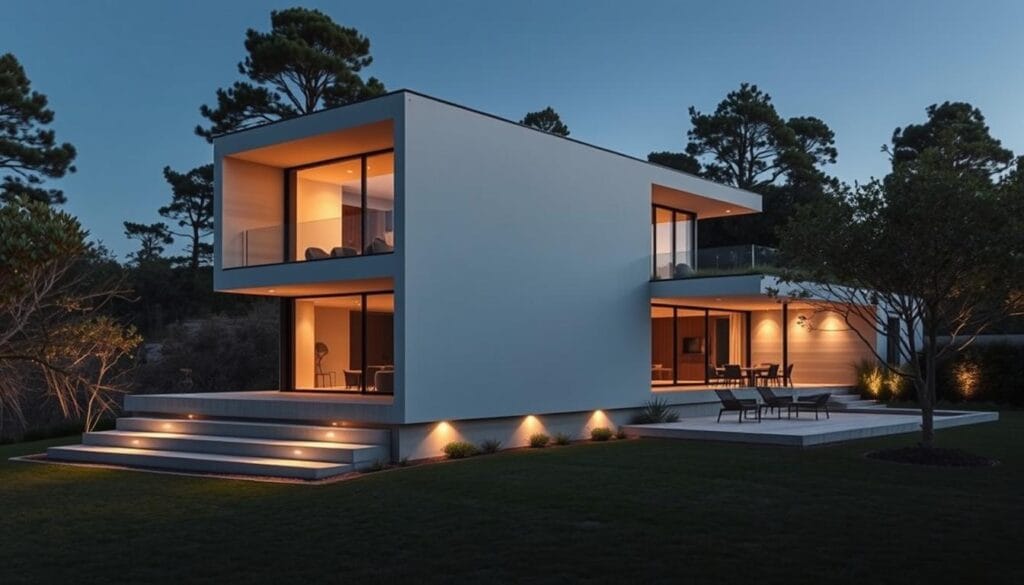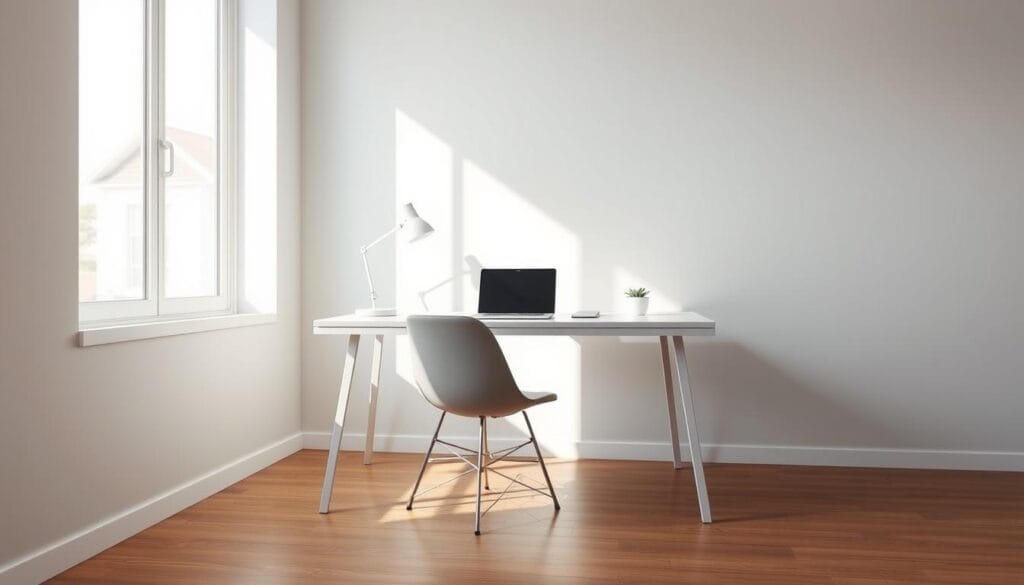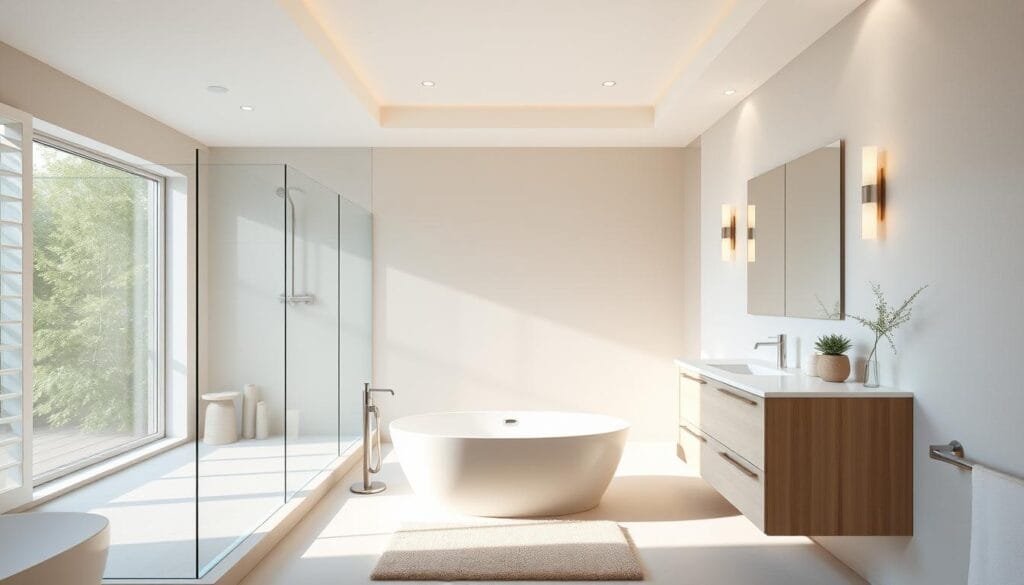Welcome to a place where less is definitely more! We’re diving into modern minimalist house design. Picture waking up in a room filled with light, with big, clear windows. Your home is a calm escape. 🌞
Imagine living spaces with clean lines and peaceful vibes. I first fell in love with this style in Marfa, Texas. A friend’s house there showed me how minimalist design can make a home elegant and functional, blending with nature.
This design philosophy brings a new kind of elegance. It draws on Scandinavian aesthetics. Minimalist homes use clean lines, raw materials like wood and concrete, and soothing colors. Let’s explore how sleek interior design makes daily life simple yet sophisticated. 🌿
Introduction to Modern Minimalist House Design
Welcome to the contemporary world of minimalist architecture. It’s a place where simplicity and function create peaceful, purposeful spaces. Minimalism is all about stripping things down to their basic qualities. It follows the “less is more” belief, focusing on function and cutting out what’s not needed.
This style not only makes a space tidy and orderly but also shows off the beauty of the materials and the space itself. Let’s explore why minimalist house design is so intriguing.
What is Minimalism in Architecture?
Minimalism in architecture means keeping things simple in terms of form, function, and materials. It’s about making spaces that are clean, open, and full of light, focusing only on what’s necessary. The aim is to create a feeling of calm and clarity.
By doing so, minimalist architecture highlights the space and materials’ natural beauty without extra decor. This approach gives a peaceful living space where every part has a reason to be.
Key Characteristics of Minimalist Design
Minimalist house design loves simplicity and beauty. It uses simple coverings, few details, and carefully chosen materials to look interesting without being too much. Here are some main features:
- Clean Lines: Minimalist homes have straight, clear lines with no extra decorations.
- Simple Geometric Forms: The shapes are simple, like squares and rectangles, and other basic forms.
- Monochromatic Palette: The colors are often neutral, creating a timeless look.
- Natural Light: Big windows let in lots of natural light, making the space bright and lively all day.
Read more about these features in this article on modern minimalist house design. These principles make the design not only look good but also practical. By choosing a minimalist design, you can make your home feel bigger and more open.
Choosing minimalist architecture means choosing quality over quantity. This can make your home more energy-efficient, cost less to maintain, and improve your happiness and health. This thoughtful approach to living brings a perfect balance between beauty and usefulness.
Benefits of Modern Minimalist House Design
Embracing a minimalist living space offers numerous advantages that can transform your home into a serene and efficient haven.
Enhanced Space Utilization
Adopting modern minimalist house designs greatly improves space use. Essential furniture and simple layouts make small areas seem bigger. This is great for those wanting to maximize their living space.
75% of smaller apartment owners use these tricks to make their place look bigger. This creates an illusion of more space.
Lower Maintenance Requirements
A minimalist living space also means less cleaning. With fewer items and simpler surfaces, upkeep takes much less time. This can cut cleaning time in half, leaving more time for fun.
Also, 80% of people living this way feel clearer and more stable mentally. This shows the emotional perks of minimalism.
The clean designs of minimalism make homes look fresh and tidy. Your home becomes stylish, practical, and easy to keep up.
Essential Elements of Minimalist Architecture
Minimalist architecture is based on clean lines and simple shapes. This creates order and balance. A lot of natural light makes the area open and lively. Neutral colors like white and beige make it calm and cohesive. These aspects make a home practical and pretty.
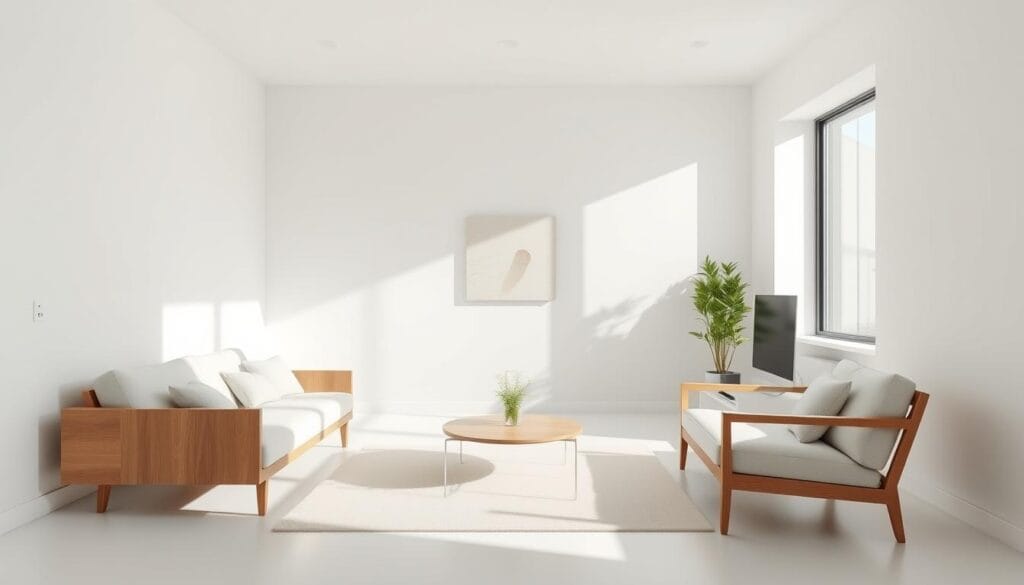
Clean Lines and Simple Forms
Minimalist homes focus on clean lines and simple shapes. This adds timeless beauty. Everything unnecessary is cut out, leaving only the needed stuff. This idea comes from “less is more,” said by Ludwig Mies van der Rohe. Architects like Tadao Ando and John Pawson show this in their work.
Natural Light and Open Spaces
Natural light is key in minimalist design. Big windows and open plans make places feel bigger and welcoming. Minimalist homes have open areas that link rooms smoothly. This improves the connection and flow inside.
Natural light cuts down the need for artificial light and brings nature inside. This adds calmness and wellness to the home. As noted in minimalist design rules, connecting with nature is crucial for a peaceful space.
Neutral Color Palettes
Minimalist decor loves neutral colors. White, gray, black, and tan are popular. They make a peaceful setting that puts focus on the house’s design and furniture. These colors help create an uncluttered and elegant look.
Using neutral shades makes the space feel open and simple. It fits with the minimalist way of focusing on the necessary, not the extra decoration. This keeps things simple and stylish.
Popular Materials for Minimalist Homes
Materials are key to minimalist house design, focusing on both looks and function. Choices like glass and steel make interiors sleek yet practical. Let’s explore the top picks for a modern, minimalist look.
Glass and Steel
Glass and steel are top materials for minimalist homes. Glass makes spaces feel bigger and more open. It lets in lots of natural light, cutting down on artificial lighting needs. This lowers electricity use a lot. Steel adds strength and a cool, industrial vibe. It’s used in things like staircases and beams, keeping designs simple and elegant.
Using double or triple-glazed windows helps keep the house warm or cool, boosting energy savings by about 30%. This makes the home not only stylish but also eco-friendly and cost-effective.
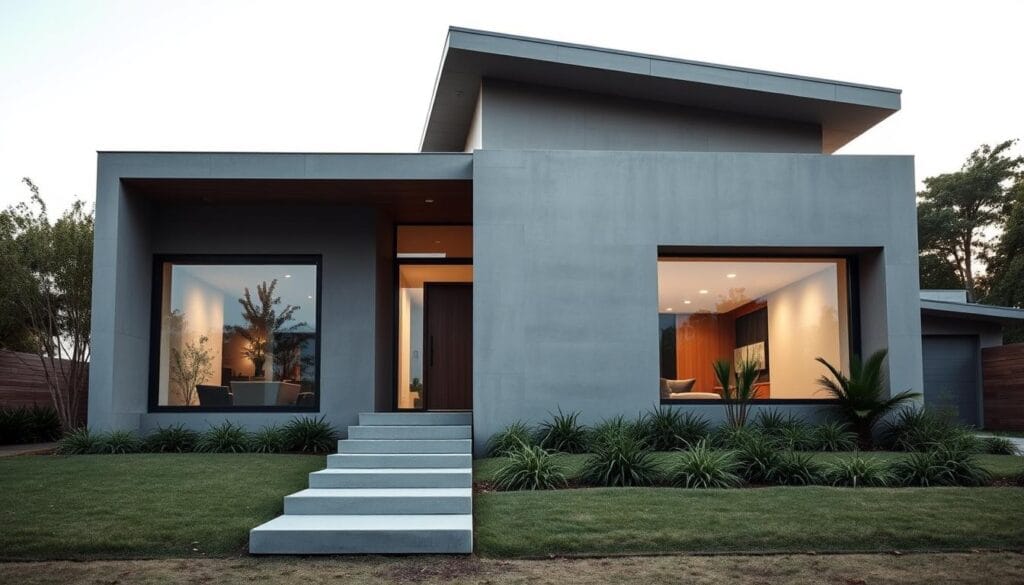
Wood and Concrete
Wood and concrete are great for adding warmth and texture to minimalist homes. They make spaces feel welcoming while staying simple. Light colors like beige and grey work best, creating a calm backdrop. Concrete adds a tough, industrial touch and helps control the home’s temperature. This mix can lower your heating and cooling needs by 15-25%.
Choosing the right materials is crucial for a beautiful minimalist home. Each choice, from glass to concrete, should focus on function and style. They come together to make a space that’s both elegant and easy to live in.
Interior Design in Modern Minimalist Homes
Turning a house into a minimalist sanctuary means choosing furniture and accessories carefully. The minimalist living style is expected to stay popular in 2024. People love calm spaces that are simple and useful.
Minimalist Furniture Choices
Picking the right furniture is key for a minimalist look. Minimalist pieces are both pretty and practical. More and more, people like furniture that saves space and serves several purposes.
For example, platform beds with their simple design are loved in minimalist bedrooms. 55% of homeowners prefer them as their main bedroom feature.
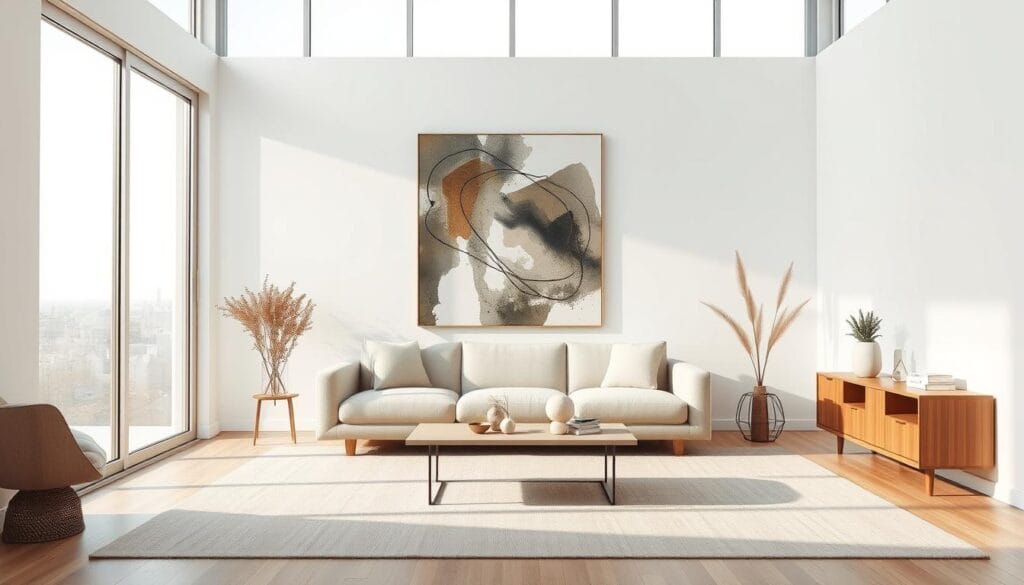
Minimalist homes often use furniture with clean lines and smooth surfaces. About 80% follow this idea. It sticks to the “less is more” mindset, making the space feel peaceful.
Functional and Aesthetic Accessories
Accessories should fit the minimalist style and be useful, not just pretty. Adding plants is common, with 40% of minimalist homes including some greenery. It makes the space feel alive and cozy.
Neutral colors like white, beige, and gray set the calming tone of minimalist design. Sometimes, a splash of color from art or decor adds a peaceful touch.
Negative space lets each chosen piece stand out, creating balance and calmness in your minimalist home. This approach helps make the space relaxing and enjoyable.
Outdoor Spaces in Minimalist Houses
Modern minimalist home ideas make the outdoors blend smoothly with the indoors. This simple clean house decor shows in the minimalist garden and design. It brings a sense of unity and peace.
Incorporating Nature and Landscaping
Adding nature to your outdoor areas boosts the minimalist feel. A big tree can be the center of a minimalist garden. In Northern California, people love Japanese Maples, Flowering Cherries, and Olive trees. These trees look good all year and help us feel calm and happy.
Keep patios and decks free of clutter for a simple, open look. Use natural materials like teak for outdoor furniture, keeping it durable and clean-looking. If you’re saving money, use perennial flowers and stones to make your backyard beautiful.

Creating Functional Outdoor Areas
It’s important to have functional outdoor spaces in simple clean house decor. Built-in seats with storage make small yards work well and look good. An outdoor kitchen can have a basic gas grill in a concrete table, mixing use with style.
Minimalist pools are usually simple rectangles that match the house. Dark fences add depth but keep the natural feel. For water saving, use gravel and mulch for an eco-friendly garden.
Related Reading: Learn more about incorporating modern minimalist home ideas into your exterior design.
Sustainable Features in Minimalist Design
Combining sustainability with minimalist home design matches the goals of being simple and useful. Let’s talk about how to make a minimalist home sustainable. We’ll focus on using less energy and choosing environmental-friendly materials.
Energy Efficiency Considerations
Energy efficiency is key in minimalist homes. We use better insulation, LED lighting, and appliances that don’t use much energy. These choices help cut down on energy use and are better for the planet. For example, LED lights last longer than regular bulbs and use less energy.
Investing in appliances that save energy, like those with an Energy Star rating, keeps your house running smoothly.
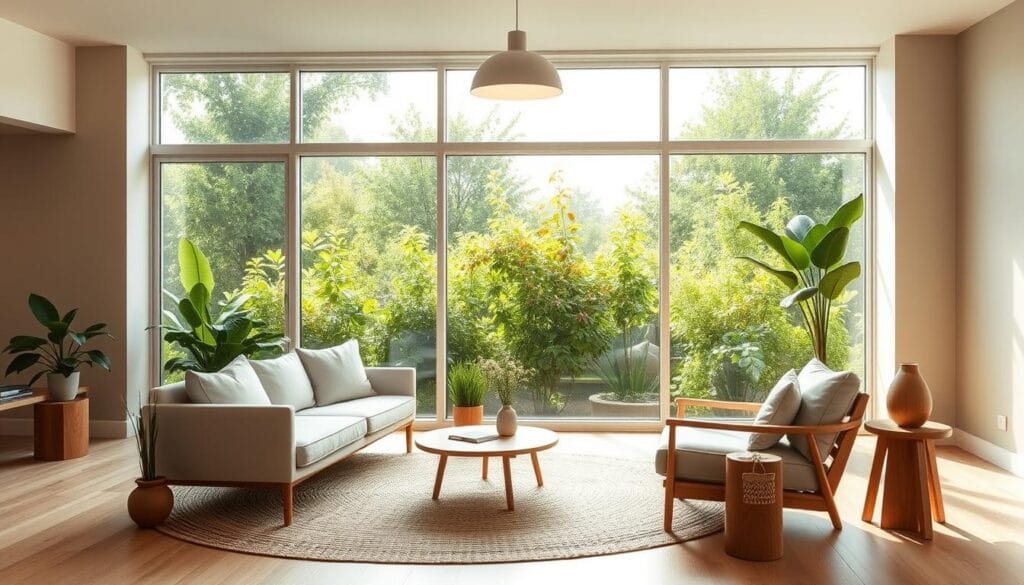
Smart thermostats are another great tool. They adjust your home’s temperature for you, saving energy. Passive design techniques also help a lot. They reduce how much heating and cooling your house needs by using smart design and materials.
Use of Eco-Friendly Materials
Minimalist design and eco-friendly choices go well together. Using things like bamboo or recycled metals is good for the planet and looks great. Bamboo grows fast, so it’s a great choice. Recycled glass and old wood are not only strong but also good for the environment. They add a special look to your home.
Choosing local materials cuts down on pollution from shipping and helps local businesses. Adding materials like stone, leather, and metal can give your home a clean, Nordic look. Also, things like toilets that use less water and efficient plumbing save water and support an eco-friendly home.
So, designing a minimalist home with sustainability in mind helps the environment and sticks to minimalist principles. By focusing on energy-saving and environmental-friendly materials, we make sure our homes are good for the earth and beautiful to live in.
Challenges of Designing a Minimalist Home
Designing a minimalist home can be rewarding but comes with challenges. Achieving the right mix of beauty and use is crucial. This ensures spaces are warm and welcoming, not cold or empty.
Balancing Aesthetics and Functionality
Minimalist homes are loved for their simplicity and spacious feel. But keeping them functional is essential. Robert Brown highlights the difficulty in focusing on practicality while maintaining simplicity.
A kitchen redesign in Central Park boosted storage by 20%. This shows we can’t ignore practical needs for minimalism’s sake. Designers know that enough storage is key to a clean and calm space. Thus, smart storage is crucial for blending functionality with minimalist design.
Common Misconceptions about Minimalism
Many misunderstand minimalist architecture, thinking it’s cold or unwelcoming. But half of the designers believe warm, inviting spaces can be achieved with simple color schemes and textures.
Also, there’s a belief that minimalist design is too simple or dull. However, 80% of designers find that light, shape, and materials can add sophistication. This keeps it from being boring.
Some worry that minimalist homes lack personality. Yet, 30% of designers say minimalism puts focus on important personal items. Done right, minimalist homes are both inviting and meaningful, showing that simplicity and warmth can coexist.
Conclusion: Embracing Modern Minimalist Design Principles
Choosing a modern minimalist design for your home is more than picking a style. It means choosing simplicity, function, and a clutter-free space. This approach changes our homes into places of calm, where everything has a purpose and adds to the peace.
Open floor plans are key in minimalist design, used in 70% of new homes. They open up the space and bring in more light. By combining open spaces with big windows, found in 90% of minimalist homes, rooms feel larger and more welcoming.
In minimalist homes, the color scheme usually includes white, gray, and beige, found in 85% of designs. These colors create a calm setting that’s perfect for minimalist living. Also, 60% of these homes use natural materials like wood and concrete, making them feel closer to nature.
Functional and versatile furniture is also crucial, used in 75% of minimalist settings. This kind of furniture helps save space and keep things looking neat. By choosing our items wisely, we can minimize clutter and make our homes feel calm and orderly. Choosing minimalist design is not about having less but about making each piece count.
Let’s bring these minimalist design ideas into our homes. By doing this, we make our homes more organized, beautiful, and useful. This leads to a life that’s clearer and more peaceful.

